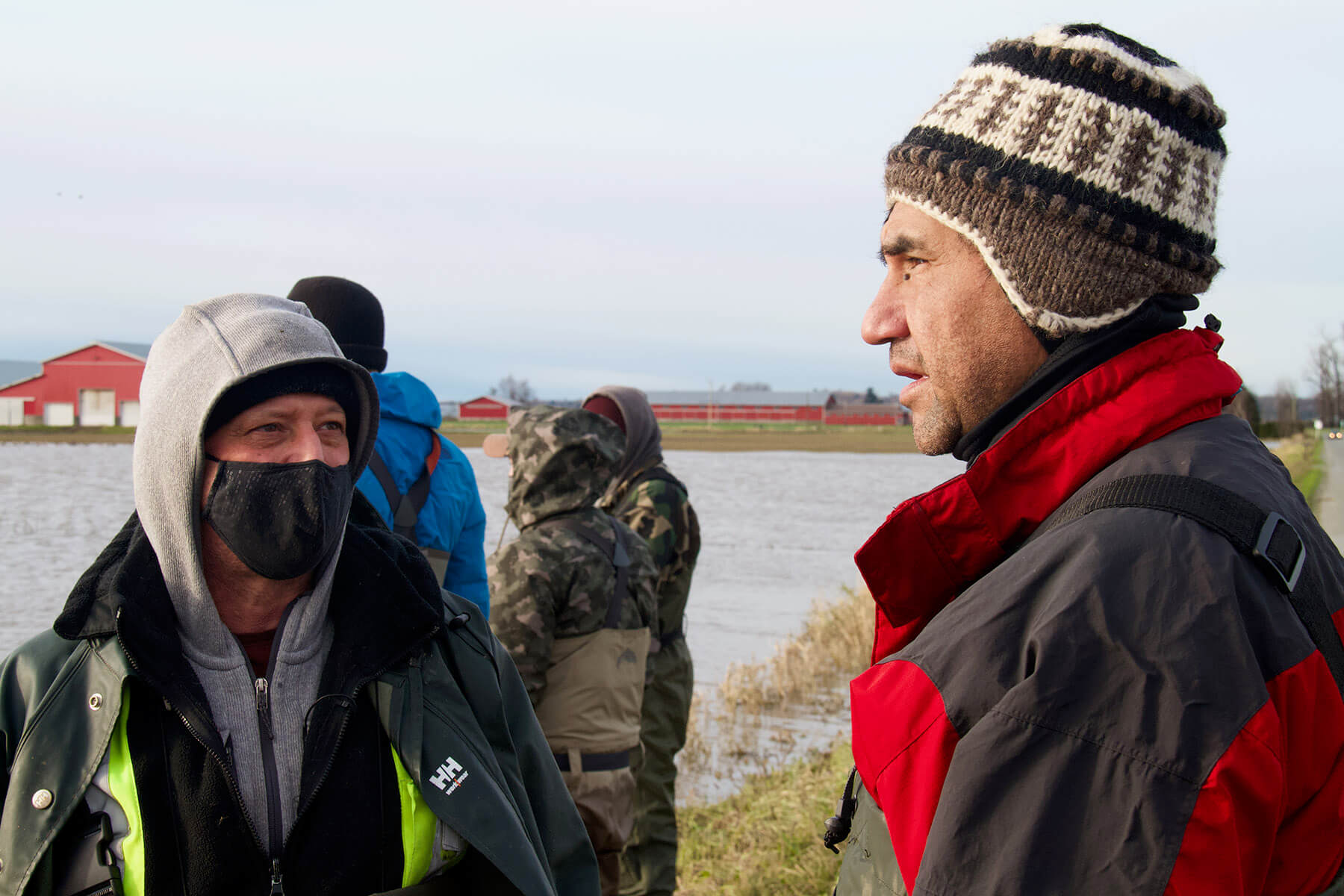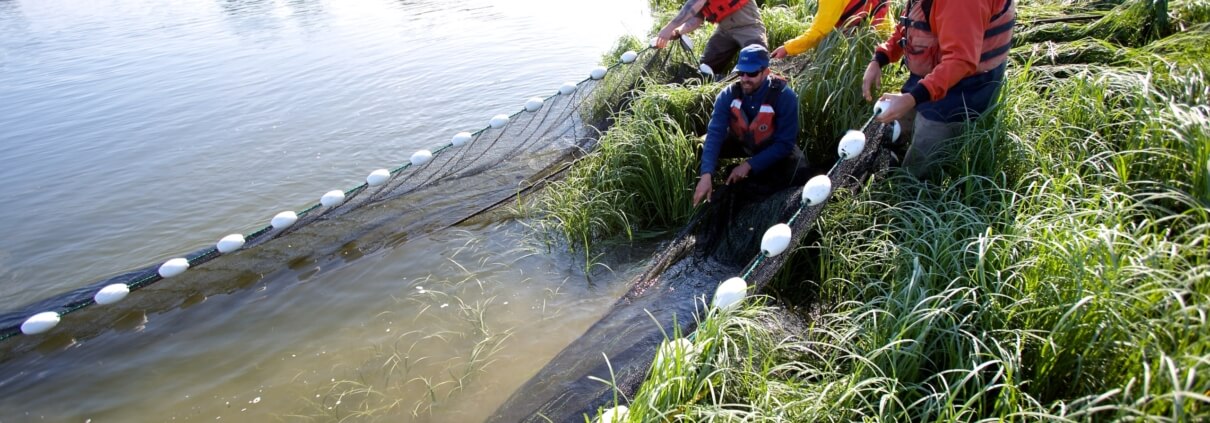Pulling for salmon
When extreme weather wreaks havoc, people pitch in
Last November passionate people put on their waders and stepped into the icy waters in the fields flooded by the Sumas River, pulling for Pacific salmon.
“These are our most endangered species of coho, so if we can save four females, then we save thousands of eggs,” says Lester Ned of Semá:th First Nation, after rescuing salmon in Abbotsford B.C.
In immediate response to the unprecedented flooding, the Pacific Salmon Foundation catalyzed action. Collaborating with the Lower Fraser Fisheries Alliance (LFFA), Semá:th Nation, Fisheries and Oceans Canada (DFO), and environmental non-government organizations, PSF rapidly funded emergency projects ranging from urgent habitat restoration to fish rescue.

From left: Biologist Dr. Mike Pearson speaks with Lester Ned of Semá:th Nation during 2021 salmon rescue.
Since November, PSF has provided more than $200,000 to support urgent flood recovery efforts. This funding has been underwritten by the Pacific Salmon Endowment Fund, which has also allocated funds for PSF to continue to show leadership on “salmon-friendly” flood planning. From the restoration of the Eaton Beaton side channel in the Coldwater River to fish rescue with the Lower Fraser Fisheries Alliance, Semá:th Nation, and StÓ:lō Nation Society, PSF has supported numerous partnerships working to save salmon.
B.C.’s recent extreme climate events were not limited to November’s atmospheric river. If you were in the province at any point between June and December 2021, you likely experienced the impact of floods, a heat dome, drought, and wildfires. Sadly, these events had terrible impacts on many communities, and also affected salmon populations around the province. As these catastrophic events are predicted to occur more frequently, salmon need our help in order to adapt to human-created conditions.
Recovery work is essential. Some populations of Chinook and coho have dropped by 90 per cent, threatening salmon dependent economies and the entire ecosystem that includes more than 130 species. Now, already struggling populations must confront life-threatening climate extremes.
“Pacific salmon are the 21st Century canaries in the coal mine. Their health reflects that of the environment. The recent B.C. floods wreaked havoc on salmon habitat and further threaten endangered populations. Although we made great strides in the initial time-sensitive recovery effort, the long-term effects are yet to be seen. PSF relies on the generosity of people who care about salmon. With your help, the future can be salmon friendly,” says Michael Meneer, PSF President and CEO.
Many salmon survived the floods. Thanks to early rescue efforts coordinated by PSF, Semá:th Nation and StÓ:lō Nation, healthy adult coho were rescued from flooded fields and released to spawn in the nearby Sumas River.
Time-sensitive, emergency projects funded by PSF include:
· Fraser Valley Salmon Habitat — 18 projects supporting at-risk habitat capable of producing several million juvenile salmon.
· Coldwater River — Eaton Beaton side-channel, a tributary to the Nicola River, one of the most important rearing habitats for coho and early-run Chinook, and the most important for steelhead. The November 2021 storms dramatically altered the course of the river; PSF supported the repair and restoration of this important habitat.
· Anderson Pond — The channel in Chilliwack was completely buried with sediment. PSF supported the reconstruction on December 10, and the next day 40 adult coho showed up and began spawning.
Infrastructure Rebuild: A “salmon first” coordinated effort is the only way
The Fraser River and its tributaries — areas severely affected by the November 2021 floods — comprise some of the most valuable salmon habitat in the world.
Effective response requires government and all of us to better prepare to ensure effective and efficient short, mid- and long-term strategies.
“Infrastructure being rebuilt right now presents the quintessential opportunity to integrate flood recovery efforts and reconstruction planning with salmon conservation. There is a finite window of time that will see post-flood rebuilding efforts either contribute positively to improving conditions for salmon or permanently harm their future,” says PSF VP Salmon Jason Hwang.
By ensuring salmon are part of the rebuilding equation, we can help nature and our ecosystems thrive.
Through a coordinated effort, governing jurisdictions must develop and implement post-flood strategies that include salmon. Our neighbours in Washington State have a program that is designed to accelerate integrated efforts to reduce flood risks and restore habitat along the state’s major river corridors. Its goal is to improve the resiliency of floodplains in order to protect local communities and the health of the environment. Infrastructure rebuilding plans here in B.C. would be wise to adopt similar strategies and approaches. We have the knowledge and opportunity to do better for people, salmon, and natural
environments.
“The urgent and important challenge is timely coordination across entities — First Nations, Federal, Provincial, and local government — for the conservation of our wild Pacific salmon,” says Hwang.


 Amy Romer
Amy Romer